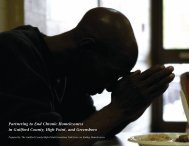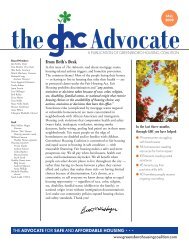data - Greensboro Housing Coalition
data - Greensboro Housing Coalition
data - Greensboro Housing Coalition
You also want an ePaper? Increase the reach of your titles
YUMPU automatically turns print PDFs into web optimized ePapers that Google loves.
One-Year Estimates of Sheltered Homeless Persons, October 2007-<br />
September 2008<br />
About 1.6 million persons used an emergency shelter or a transitional housing program<br />
during the 12-month period (October 1, 2007 through September 30, 2008), suggesting that 1<br />
in every 190 persons in the United States used the shelter system. The nation’s sheltered<br />
homeless population over a year’s time included approximately 1,092,600 individuals (68<br />
percent) and 516,700 persons in families (32 percent). A family is a household that includes<br />
an adult 18 years of age or older and at least one child. All other sheltered homeless people<br />
are considered individuals. Considered as households rather than separate people, there were<br />
159,142 sheltered families, about 14 percent of all sheltered homeless households.<br />
The total number of sheltered homeless persons remained essentially unchanged between<br />
2007 and 2008, increasing by only 5,200 people. However, the household composition of the<br />
sheltered homeless population shifted somewhat between 2007 and 2008. The number of<br />
homeless individuals was fairly stable, while homelessness among persons in families<br />
increased by about 43,000 or 9 percent. Accordingly, the share of family households among<br />
all sheltered households also increased, by nearly 3 percentage points.<br />
Sheltered Homeless People in 2008<br />
The one-year estimates based on HMIS <strong>data</strong> include detail on the demographic<br />
characteristics of the 1.6 million people who were homeless in a shelter some time over the<br />
course of a year, where they were before they entered the residential program, and for how<br />
much of the year they stayed in the shelter.<br />
The most common demographic features of all sheltered homeless people are: male,<br />
members of minority groups, older than age 31, and alone. More than two-fifths of sheltered<br />
homeless people have a disability. At the same time, sizable segments of the sheltered<br />
homeless population are white, non-Hispanic (38 percent), children (20 percent), or part of<br />
multi-person households 1 (33 percent).<br />
Approximately 68 percent of the 1.6 million sheltered homeless people were homeless as<br />
individuals and 32 percent were persons in families. When compared to family members,<br />
people who use the homeless residential system as individuals are particularly likely to be<br />
men, middle aged (between the ages of 31 and 50), and to have a disability. About 13<br />
percent of sheltered homeless individuals are veterans. By contrast, sheltered homeless<br />
families are very likely to be headed by a woman under age 30 without a male partner. A<br />
1<br />
This includes multi-adult and multi-child households that are counted in the AHAR as separate individuals,<br />
as well as family households composed of at least one adult and one child.<br />
Executive Summary<br />
iii




